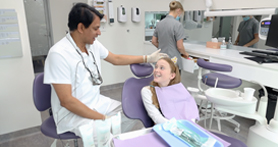Orthodontic treatment procedures deal with correcting the alignment of teeth. It is primarily about repositioning of teeth to improve the appearance and smile of a person.
The dental health of the person is thus improved along with giving the needed support to the gums, while also ensuring that the pressure of chewing/biting is not concentrated in just one part of the mouth.
There are different types of orthodontic appliances – both fixed and removable, that help with correcting the alignment of the teeth and jaws. The focus of treatment is not just on appearance but also on boosting overall dental health and support. Misalignment of the teeth is caused due to overcrowded teeth, teeth that are irregular, or buck teeth. Due to these conditions, dental health is also affected.
When teeth are overcrowded then there are high chances of food particles being trapped in between them. Food particles attract bacterial action, the bacteria will act on these food particles and release an acid that will erode the teeth and their protective structure. This will then bring in the decay of the teeth. Irregular teeth placement or protruding teeth indicates how the jaw arch is placed and how both the jaws are not covered by the lips. This position of the jaws and teeth will also affect the bite function and will bring extra pain to the neck and jaw muscles.
Orthodontics and dental support
Orthodontics supports the dental health of the person by way of its devices and also procedures. Some of the main procedures are discussed below.
Fixed orthodontic appliances
Fixed orthodontic appliances come in different forms such as braces, space maintainers etc. They are attached to the teeth for a period of time as calculated by the dentist.
Braces:
Braces come in the traditional metal bracket form and also in different colours. They hold the teeth in their position and rubber bands are available that will keep the appliance in its position. These braces are checked by the dentist during consultations and adjusted. While adjusting the braces are tightened and this pressure will slowly move the teeth into the desired position. Braces need to be worn for over a year generally to obtain the desired effect.
Space retainers:
Space retainers are supporting devices that are generally used for children. During their development children lose their baby teeth and permanent teeth appear in their position. But teeth decay is something that affects everyone alike. Children usually consume sugary food and they often remain in the mouth of children. Bacterial action is manifold in these cases. If proper dental cleaning like brushing and flossing is not done then children will have tooth decay. This causes the teeth to either fall off early or need to be extracted. Baby teeth fall off before their time and there will a space available for the adult teeth that have not yet appeared. To make sure the neighbouring teeth do not shift their position into the available space the space retainers are kept – they will hold the space for the permanent teeth that will take up the space.
Removable orthodontic appliances
Orthodontics also provides removable appliances for providing dental support. Now, unlike the fixed devices these can be removed and cleaned and re-fitted for use. There is more comfort in using these devices as they can be removed during eating and cleaning teeth and there is less interference from them. Usually these removable appliances are used when there are minor corrections to be made to the dental makeup of the person.
Clear aligners:
Clear aligners come in this category of devices. They are clear plastic trays that are placed on the teeth of the person and help provide support to the teeth. They are able to move the teeth for a small fraction and help obtain the desired alignment. They are invisible as they are clear and as they are custom made they are able to provide the support needed to the dental framework. It is important to keep these clear aligners clean as if there are food particles trapped in them, they will easily be visible.
Retainers:
Retainers help keep the teeth and jaw in position after they have completed the course of treatment using braces. There will be slight changes to the teeth and jaw lining in a person as the tissues are living and changing slowly. These retainers help the dental framework of the person stay in the position which is achieved by using braces. They are thin metal wires that help keep the teeth in position. They can be easily removed and cleaned. They must be used for a certain period as suggested by the dentist.
Other orthodontic devices
Other orthodontic devices are used for more major restorative treatment.
For example, temporomandibular joint (TMJ) disorders cause pain and discomfort while trying to move the jaws. They are present on each side of the jaw and act as a hinge, when their work or movement is affected, they need to be corrected. Problems while moving the jaws, bite issues, grinding, and pain while chewing, facial muscle problems and issues with sight are all seen due to TMJ.
Splints are used to help reposition the jaws and reduce the mentioned symptoms. The splints are fitted to the upper jaw and lower jaw and help to prevent the grinding issue as well as ensure more alignment with the jaw points.
Another device that is used for children especially is the headgear. Overbite can be corrected using this. The teeth and jaw that is protruding is pushed back using this headgear. The device is attached to the face or head with a strap. These are placed when the child is at the stage of rapid bone growth usually 9 years or older. Early intervention is possible and jaw abnormalities can be fixed using this appliance.




